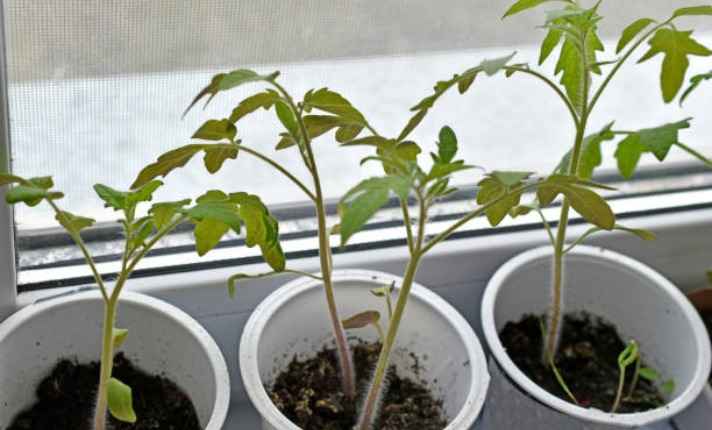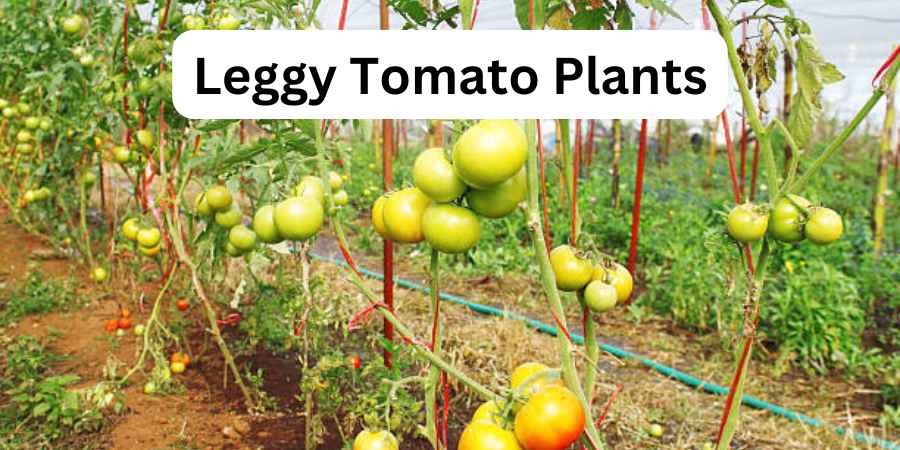Tomatoes are a delicious fruit that many people grow at home. They are part of the Solanum lycopersicum family. These plants have a long history and are known for their unique umami flavor.
Tomato seedlings often become leggy and spindly if they don’t get enough light. This problem can make the plants weak. Gardeners who start their seeds indoors see this problem often.
Leggy plants happen when the seedlings are too far from the light source, causing them to grow tall and spindly instead of strong and sturdy.
Starting seeds too early can also cause leggy plants. In this article, we will discuss the causes of leggy tomato plants, how to prevent it, and tips to save your seedlings to ensure they grow healthy and productive.
Table of Contents
ToggleWhat Are Leggy Tomato Seedlings?
Leggy tomato seedlings are tall and spindly. They have thin stems and are often pale. This happens when they don’t get enough light. Without enough light, seedlings stretch towards it and become weak.
To fix this, give seedlings more light. Use extra light if needed. Avoid overcrowding. Give each seedling enough space to grow. Overcrowding makes them weak.
If seedlings are already leggy, bury part of the stem when transplanting. This helps them grow deeper roots and makes them stronger. Use stakes to keep the thin stems from falling over.
Water the plants regularly. Keep the soil moist but not too wet. This helps them stay healthy.

Why Is Legginess a Problem for Tomato Plants?
Leggy tomato plants are weak and hard to support. They have thin stems that bend and break easily. They also have shallow roots, making it hard for them to absorb water and nutrients.
These plants are more likely to get pests and diseases. They can’t defend themselves well. When transplanting, their shallow roots struggle to take hold. This affects their growth and fruit production.
To prevent this, give seedlings enough light and space. Use larger containers for repotting so their roots can spread out. This helps them become strong and healthy.
Fix leggy tomato plants and check if your fertilizer and potting soil are still good:
Causes of Leggy Tomato Plants
Leggy plants often result from a combination of factors that can be easily avoided with proper care. These causes can stunt the growth of your plants and reduce their ability to produce fruit.
| Cause | Impact |
| Insufficient Light | Low light exposure is a major cause of leggy plants |
| High Temperatures | Leggy growth is common in temperatures above 85°F |
| Overcrowding of Seedlings | Overcrowding leads to significant leggy growth |
| Improper Soil Depth | Shallow planting often results in leggy plants |
| Inadequate Watering Practices | Incorrect watering affects tomato plants’ growth |
How to Fix Leggy Tomato Plants
With the right light, soil, and care, your tomato plants will grow strong and healthy. By following these tips, your plants will establish firmly and produce sweet, delicious tomatoes.
1. Adjust Light
Move the plants to a sunny spot. They need 14-16 hours of light each day. Fluorescent lights can help if you don’t have enough sunlight.
2. Improve Soil and Potting Mix
Use a mix of peat, coconut coir, and perlite. This mix keeps the soil moist but not wet. Avoid overwatering to prevent root rot.
3. Transplant Deeply
When you transplant, bury the stem up to the first set of leafy leaves. This helps the plant develop more roots and become firm.
4. Water Properly
Water the plants gently and keep the soil moist. Use your finger to check the soil. It should feel like a damp eraser.
5. Maintain the Right Temperature
Keep the plants in a place where the temperature is between 65-75 degrees Fahrenheit. This warmth helps them grow and adapt.
6. Provide Nutrients
Feed your plants with compost or a balanced fertilizer. This provides the necessary nutrients for healthy growth.
7. Use Supports
A stake or cage is used to support the stem and anchor the plant as it grows.
8. Thin Seedlings
If you have many seedlings, thin them out. Keep the strongest ones, about 2 inches apart, to avoid crowding.
9. Prepare for Outdoor Conditions
Before moving plants outdoors, let them adapt to weather changes. Place them outside for a few hours each day to get used to the new conditions.
Survival of Leggy Tomato Seedlings
Sometimes, tomato plants grow too tall and thin when they don’t get enough light. This can make them look weak and shaky. But don’t worry, with some care, these plants can still become strong and healthy.
Can Leggy Tomato Seedlings Be Saved?
Yes, you can help these tall, thin seedlings! One way to save them is to plant their stems deeper in the soil. When you do this, the buried part of the stem will grow new roots, which helps the plant become stronger.
Another way to help is to give them more light. Move the seedlings to a brighter spot, like a sunny window, or use a grow light. This extra light will help them grow sturdy and strong.
Will Leggy Tomato Plants Produce Fruit?
Yes, even if your tomato plants start long and thin, they can still grow tomatoes. To help them, make sure they have good support. You can use sticks or cages to keep them upright and prevent them from falling over. Also, remember to water them regularly and use good, nutrient-rich soil. With the right care, these plants will become healthy and produce delicious tomatoes for you to enjoy.
Care Tips for Tomato Plants
Tomato plants are a wonderful addition to any garden. To keep them healthy and productive, it’s essential to follow a few key care tips. Here is a helpful table to guide you in avoiding leggy growth and boosting tomato plant productivity:
| Topic | Care Tips |
| Seedlings | Start with quality seeds. Seed-starting in well-drained soil ensures strong seedlings. |
| Sunlight | Tomato plants need at least 6-8 hours of sun daily. South or west-facing spots are best. |
| Water | Water regularly but not too much. Keep soil consistently moist but not wet. |
| Pruning | Prune leggy stems and branches to encourage new shoots and better air circulation. |
| Support | Use a cage or stake to support the vines. This helps tomatoes grow firm and good-colored. |
| Soil | Use organic compost to improve soil quality. Tomato plants need well-drained soil. |
| Location | Choose a spot with good air circulation and sunlight. Avoid damp locations. |
| Fertilization | Use a balanced fertilizer. Fertilize regularly to maintain healthy growth. |
| Temperature | Tomatoes grow best in warm temperatures. Avoid planting too early in the season. |
| Harvest | Pick tomatoes when they are colored and firm. Harvest regularly to encourage more fruits. |
FAQ’s
Q: How Do I Keep My Tomato Plants Short and Stocky?
A: Prune the suckers and pinch the stems to keep tomato plants short and bushy. Use stakes or ladders for support. Provide wide space in the garden and use premium soil.
Q: Why Is My Tomato Plant Growing So Tall but No Tomatoes?
A: Leggy tomato plants can be a common issue with a deficiency in nitrogen. Leaves might be yellow and foliage becomes stunted. This affects fruiting despite the plant looking lush and massive. Balance soil fertility for better growth and more tomatoes.
Q: What Happens if You Don’t Prune Tomatoes?
A: If you don’t prune your tomato plants, they will eventually grow really big and form clusters of smaller fruits. The vines will spend their energy on suckers, making the overall plant less productive. Pruning helps direct nutrients to the fruit that needs it most.
Q: How Many Leaves Should I Take off My Tomato Plants?
A: To keep tomato plants healthy, remove 1/3 leaves. This balances vegetative growth and fruit production. It helps tomatoes grow better.
Q: Which Branches to Cut off the Tomato Plant?
A: Cut the weaker branches and suckers from the main stem first. Remove lower leaves that don’t produce flowers or fruit. Trim upper branches with large clusters to allow more sunlight.
Conclusion
Leggy tomato plants need enough light, water, and nutrients. If they become tall and thin, move them to a sunnier spot, use grow lights, and ensure they have good soil. Transplanting them deeper and pruning them can help them grow stronger. With proper care, your plants will become healthy and produce many tomatoes.

